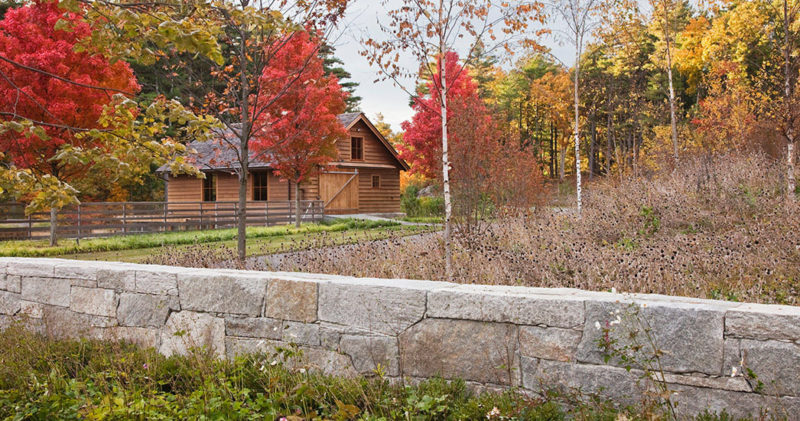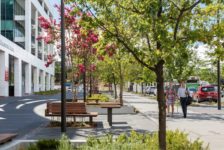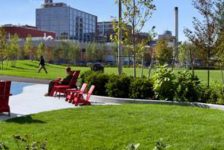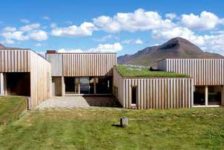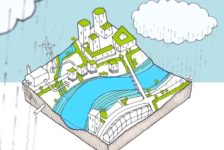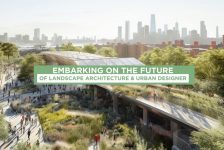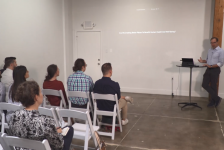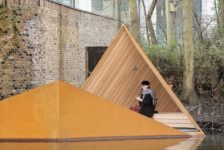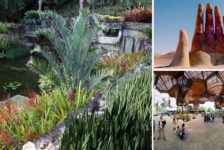Typically designers need no convincing that sustainable design is necessary to protect the earth’s health, its resources, and its ecosystems. Sustainable design is becoming an increasingly comfortable topic in the public and corporate sectors too, regardless of whether the motivation for that shift is well-intentioned or simply a PR strategy. In residential design though, it is difficult to ask clients to foot the bill for something they do not value. How can landscape architects approach residential design in a way that encourages sustainable design practices when our clients’ values do not match our own?
A number of practical methods can help us approach sustainable design in the residential sector. Many of them require us to capitalize on the benefits of sustainable design beyond those purely environmentally based.
1. Incorporate Sustainable Practices as a Matter of Fact
Some aspects of sustainable design can simply become part of the company’s design ethics. Without a question, absolutely critical is using McHargian principles, which focus on designing in tandem with nature instead of opposing it. Other fundamental elements in the designer tool kit include shading houses in summer, providing wind blocks in winter, utilizing solar heating, and implementing other passive systems to reduce energy use. Another fundamental practice is using a primarily native plant palette. In recent years, the commercial availability of native plant species and cultivars at local nurseries has exploded. While the field still needs improvement – I have had difficulty with the quality of native plants purchased from nurseries on numerous occasions—creating a demand is the only way to grow the market for high-quality native plants. All these practices do not even need to be overtly labelled as being “sustainable.” The client indeed may not even understand this layer of design – although it is also our responsibility as stewards to educate – if it becomes a basic part of the design.
Using native plants that provide ecological function is a key part of sustainable design. Image credit: Michael Morton.
2. Find Economic Incentives
Money is a powerful motivator. Showing that sustainable design strategies can save money is one of the most compelling ways to sell environmentally conscious design. One major incentive accounts life cycle cost. Specify LED landscape light fixtures—which are quickly becoming the industry standard—instead of traditional halogen bulbs. It may require a larger upfront investment, but reduced energy use and increased longevity will save the client money in the long term. The same goes for irrigation systems. Use intelligently grouped planting zones and water-saving rotor heads to eliminate wastefully over-watering plants. Design also for durability or re-usability to reduce long term material costs greatly. A landscape designed to last for 60 years or more will cost more than one designed for 10 years. While the initial investment may be greater than what the client expected, it is our responsibility to explain that the long term cost—both financially and in resource consumption—will be lower. On the other hand, if the client intends to renovate the landscape frequently, design site elements so that than can be easily removed and re-used, hopefully on-site.
(Related Resource: Designing the Sustainable Site with Heather Venhaus)
Another type of financial incentive is stormwater tax. Local municipalities have begun to tax residents based on their impermeable surface coverage. Politics aside, for landscape architects this type of legislation is highly useful in providing the incentive needed to implement green stormwater management. In these situations utilizing permeable paving, rainwater harvesting, and bioretention can create monetary savings for the client. Given the infancy of many of these codes, however, be prepared to defend green technologies to the local municipality as the designer. Many building and zoning codes are not nuanced enough to credit a proven design solution with the benefits it deserves.
A wealth of environmentally conscious design strategies and products that reduce resource consumption exist and are becoming increasingly accessible to designers. The economic incentive represented by these technologies is a powerful tool in advancing sustainable design.
Bioretention has thoroughly proved itself as an effective form of green infrastructure. With keen aesthetic design, it can become a dramatic element in the residential landscape. This bioretention swale was part of a 2012 ASLA Honor Award project designed by Stephen Stimson Associates. Image credit: Stephen Stimson Associates Landscape Architects
3. Use Green Products Wisely
Not all green products are made equally, and as a result, discernment is necessary when designing with them. Regardless of the sector, it is the responsibility of the landscape architect to understand the products specified. In the residential sector, however, it is wise to avoid specifying unproven technologies unless the client is excited about sustainability. If a product is new or unfamiliar, it implies an inherent risk and extra hassle since new technology always has a learning curve. Those clients who are proponents of environmentally sustainable design will be more willing to work through the issues—and potentially added expense. Finding technologies then that have demonstrated sustained performance, such as permeable paving, are key for using sustainable practices in everyday design.
 This pool in Copenhagen Harbour designed by Bjarke Ingles Group was created to show how that cleaning the river can lead to more opportunities for fun. Image credit: Bjarke Ingles Group.
This pool in Copenhagen Harbour designed by Bjarke Ingles Group was created to show how that cleaning the river can lead to more opportunities for fun. Image credit: Bjarke Ingles Group.
4. Appeal to the Client’s Desires
Danish designer Bjarke Ingels makes a point of targeting people’s desire for fun and beauty. His strategy for creating vibrant spaces in the public realm can be transferred to the private scale. If an environmental benefit can be translated into exciting design, then its primary role is seen as exciting, and the environmental benefit ostensibly plays a secondary role. In residential design, translating this philosophy into practice can be as simple as capitalizing on the aesthetic trendiness and low maintenance of non-lawn yards or using local fruit-bearing trees to add delicious goodies to someone’s backyard. The same philosophy could be used as the basis for powerful design decisions, for example making stormwater management a dramatic part of a client’s landscape. Good sustainable design will not only provide ecosystem services as a result of creating healthy habitats, but to be truly successful, it will also provide human services.
These strategies are good starting points. Fortunately, there is much more to practicing sustainable design in residential landscape architecture. I want to hear what works for you! Please comment with the strategies you employ.
Lead Image Credit: Charles Mayer
Published in Blog

